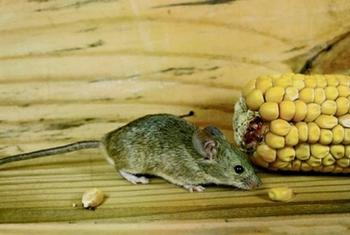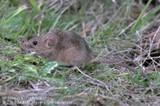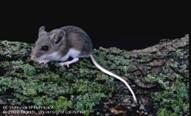Winter 2023-24
Tips for dealing with mice

As winter approaches, mice are looking to get out of the cold, seeking shelter, and building nests in our houses, garages, sheds, and other buildings. This year, some East Bay communities are experiencing higher than usual concentrations of mice due to last winter’s heavy rains and this summer’s mild temperatures. While we haven’t had similar reports in Marin County, in general mice infestations are a common problem. In fact, nationwide they are about ten times more likely than rat infestations. So it pays to know how to prevent mice, detect an infestation, eliminate them, and, perhaps most importantly, take precautions against disease when dealing with them.
Two most common types of mice
- House mouse (Mus musculus). The house mouse is one of the most troublesome rodents in the United States, thriving in and around homes and commercial structures, as well as in open fields and on agricultural land. The key house mouse identification clues are:
 The house mouse has relatively large ears and is usually light brown to gray. Photo: Jack Kelly Clark
The house mouse has relatively large ears and is usually light brown to gray. Photo: Jack Kelly Clark- Small size: an adult weighs about a half ounce and is about 5 to 7 inches long, including a 3 to 4-inch almost furless tail.
- Relatively large ears and small black eyes
- Usually light brown to gray
- Deer mouse (Peromyscus maniculatus). The deer mouse is the most abundant and widely distributed mammal in North America. It is one of seven species in the genus Peromyscus, and in California it is the most widespread and common of the seven. Because deer mice prefer forests, grasslands, and agricultural crops, they aren’t normally found within urban and residential areas unless fields, forests, or other suitable habitats surround those areas, but in Marin we have plenty of those! The key deer mouse identification clues are:
- White undersides, legs, and feet (It is often referred to as the white-footed mouse.)
 Deer mice have white undersides and larger eyes, ears, and overall body size than the house mouse. Photo: Jack Kelly Clark
Deer mice have white undersides and larger eyes, ears, and overall body size than the house mouse. Photo: Jack Kelly Clark - Dark to light brown back
- Tail is bicolored, white on the bottom and dark colored on top
- Typically has larger eyes, ears, and overall body size than the house mouse
- Most easily distinguished from house mouse by its bicolored tail
Damage caused by mice
Because of their small size, mice can get into many buildings and often enter vacated homes, cabins, and other structures where they build nests and store food. They can damage upholstered furniture, mattresses, clothing, paper, or other materials they find suitable for constructing their nests.
House mice consume and contaminate food meant for humans, pets, livestock, or birds, and can cause considerable damage to structures and property. They can also transmit pathogens that cause diseases such as salmonellosis, a form of food poisoning.
Deer mice are of particular concern because they can spread Hantavirus (Sin Nombre). Hantavirus can be deadly to people because it can cause Hantavirus Pulmonary Syndrome (HPS). Although human cases are rare, HPS can be severe, with fatality rates of about 36 percent.
How to detect a mouse invasion
There are several telltale signs of a mouse infestation.
- Droppings, fresh gnaw marks, and tracks all indicate areas where mice are active.
- Look behind boxes, in drawers, in garages, or around woodpiles for nests made of finely shredded paper or other fibrous material.
- Check for the musky odor associated with house mice.
- Caches of food supplies such as acorns, seeds, or nuts – these usually indicate deer mice rather than house mice.
- Mice are most active at night, but you also can see them during daylight hours.
How to prevent mice from invading
The key to successful long-term mouse control is limiting shelter and food sources wherever possible.
Eliminate shelter -- Mice can enter through openings as small as one-quarter inch. Eliminating places where mice can find shelter is important. Without places to hide, rest, build nests, or rear their young, mice can’t survive in large numbers.
- Use stainless steel scouring pads as a temporary plug.
- Use wire screen to cover openings. Plastic screening, rubber, vinyl, insulating foam, wood, and other gnawable materials are unsuitable for keeping mice out.
- Fit chimneys with a spark arrester.
- Install self-closing flaps on external clothes dryer vents.
- Seal cracks in building foundations and around openings for water pipes, vents, and utility cables with metal or concrete.
- Doors, windows, and screens should fit tightly. Cover the edges of doors and windows with metal to prevent gnawing.
Eliminate other habitat -- Make your garden less hospitable to deer mice:
- Clear overgrown shrubs, hedges, and weeds to reduce cover and potential refuge.
- Keep wood, brush piles, and fallen trees from homes and other buildings. These are prime nesting areas for deer mice.
Eliminate food sources -- While good sanitation may not completely control mice, poor sanitation is sure to attract them and help them to thrive. Be sure to:
- Feed pets only the amount of food they will eat in a single feeding.
- Keep all food storage and garbage containers sealed.
- Keep all trash cans covered (metal cans and covers work best).
How to manage a mouse invasion
- Traps are the safest and most effective method for controlling rats and mice in and around homes, garages, and other structures. A variety of traps are available, and using them correctly is important.
- If possible, avoid glue boards and rodenticides, which can cause other problems. Learn more about these methods here.
Precautions when dealing with deer mice
Deer mice shed the Hantavirus in their saliva, urine, and droppings. Disturbing or cleaning rodent droppings or nests or living or working in rodent-infested settings exposes a person to hantavirus by breathing contaminated dust. The most effective way to avoid contracting hantavirus from deer mice is to keep them out of houses, cabins, and dwellings. But once deer mice infest a dwelling, it is critical to avoid working and sleeping in these areas until the infestation has been controlled and the area has been made safe for humans. Learn more about avoiding Hantavirus after a deer mouse invasion and cleaning up after a rodent infestation.


